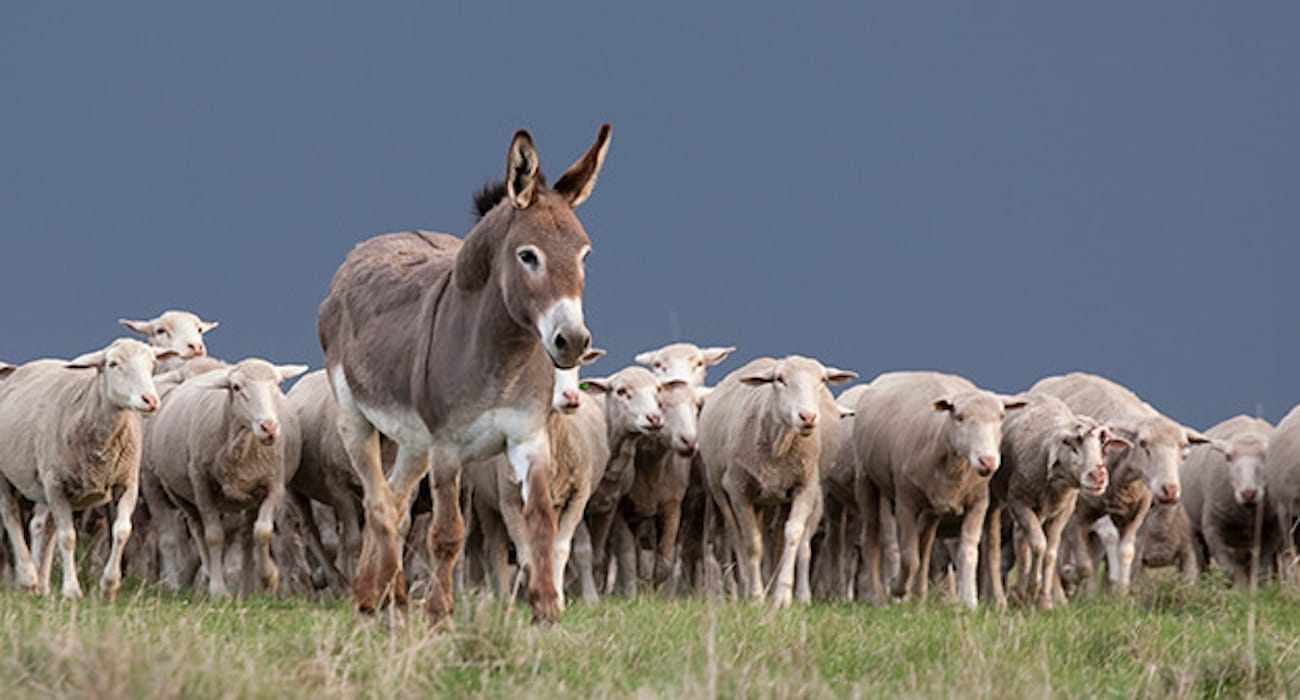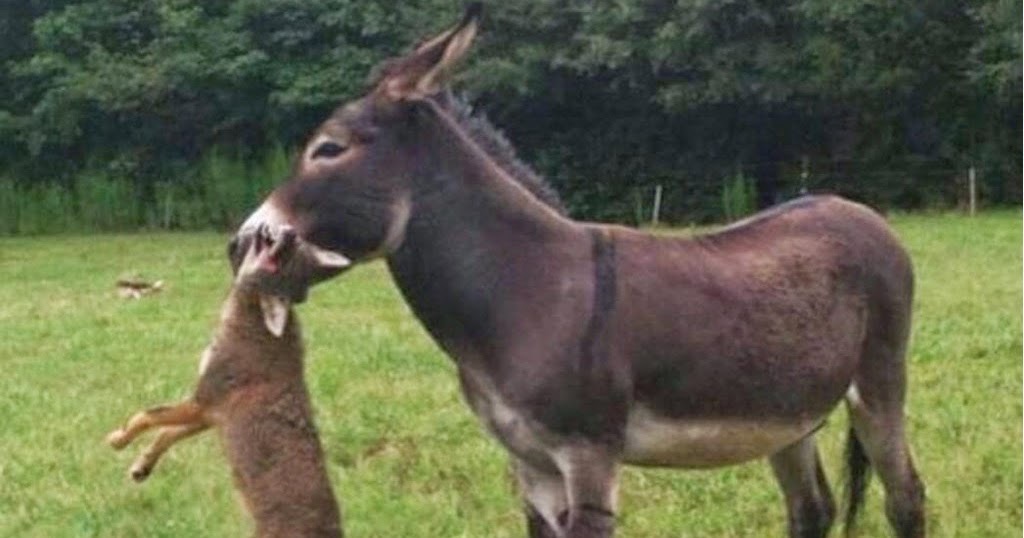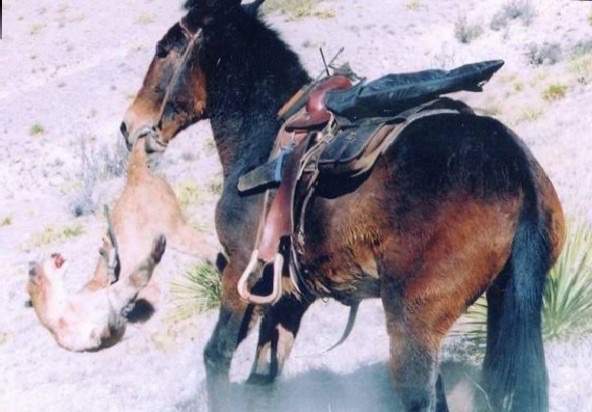Ranchers Deploy Donkeys Against Dingoes in Australia

In yet another example of species that have the same diet being complementary not competitive, burros and horses (equids) will defend other species such as sheep against predators. If we think outside the box, perhaps the equids’ inbred hostility to coyotes, wolves and lions might make them useful in protecting wild species against predation. Countless benefits like this occur all the time in biodiverse animal and plant communities. How much money is wasted on predator “control” every year, and what if a tiny fraction were redirected to explore the potential of exploiting this natural behavior?
NOTE: This article Originally Appeared in Wall Street Journal Online Oct. 24, 2013. It was written by By ROSS KELLY and STEPHEN BELL
PERTH, Australia—Growing packs of wild dogs are endangering Australia’s wool industry, leading desperate farmers to resort to unusual methods—like deploying donkeys as bodyguards—to protect dwindling livestock flocks.
Elsewhere in the country, lawmakers have placed bounties on dogs as part of a struggle to contain a problem wool-industry leaders say is reaching crisis levels.
Bruce Lines, a livestock trader from Queensland state in eastern Australia, last year rounded up more than 100 feral donkeys roaming the deserts of the Northern Territory and sold them to farmers in need.
Donkeys, along with alpacas and maremma sheepdogs, have long been used in other countries to protect livestock from predators like wolves and coyotes, but are rarely deployed in Australia.
Donkeys, renowned for their protective instincts, typically attack wild dogs and scare them away once the donkeys have been embedded in flocks and bonded with the sheep.

“You don’t have to teach them to hate canines. It’s innate. It’s in them,” said Andrew Martin, a fourth-generation farmer in Tambo, Queensland.
For mature donkeys, Queensland farmers paid about 400 Australian dollars (US$379) per head. “But we could have charged what we wanted,” said Mr. Lines, who is planning to round up another 200 donkeys to meet demand.
Nationwide data on wild-dog numbers or attacks aren’t available, but authorities say the animals roam most of the country and their population is expanding. Driving the increase is a greater availability of food like rabbits following the end of a decadelong drought. Also having an impact: fewer hands working the land as older farmers retire and their children choose more-lucrative careers in cities.
“Wild dogs have hit us with a vengeance this year,” said Emma Foulkes-Taylor, a fourth-generation farmer whose family has run a remote sheep station in Western Australia state since the Great Depression.
The problem has become so bad that Ms. Foulkes-Taylor recently decided to sell off her stock.
“It’s just not economic for us to keep running sheep, not to mention the emotional side of it—putting your sheep out there knowing they’re going to be mauled or killed,” she said.

The annual cost of dog attacks on sheep and cattle likely runs into hundreds of millions of dollars, said Woolproducers Australia, the wool industry’s main lobby group. In September, the organization published a draft plan to contain the threat, including a call for nationally coordinated action. Public responses to the draft document were due Friday, ahead of the release of a final plan early next year.
“If we don’t get on top of this, we could end up with no wool industry in Australia,” Woolproducers chief executive Jane Brownbill said.
Australia is the world’s biggest producer of fine wool, thread that is woven into expensive suits on sale in London’s Savile Row and Milan. Australian wool exports in the year through June were valued at A$2.86 billion.
Sheep and cattle farms also supply fast-growing Asian economies like Indonesia with meat.
Wild dogs include dingoes—the golden, short-haired dogs introduced to Australia thousands of years ago from Asia—domestic dogs gone feral, and hybrids of the two. Dingoes were famously found responsible for the disappearance of 9-week-old girl Azaria Chamberlain in 1980 near Uluru, which inspired “A Cry in the Dark,” a 1988 movie starring Meryl Streep.
Traditional containment techniques include laying poison bait and traps, which are labor-intensive, or keeping dogs out with fences that are often expensive to build. Such limitations are prompting more farmers to explore other options.
Michael McFarlane, a ranger in New South Wales state, added donkeys to a flock of 4,000 sheep this year after their owner lost around 50 animals in two dog attacks around Christmas.
“Since we’ve bonded them with the sheep, we haven’t had any kills on that property,” said Mr. McFarlane, who has ordered 19 more donkeys for the Ardrossan farm near Holbrook. “Whether it’s good luck, or good management, time will tell.”
Mr. Martin said donkeys had proved so successful at keeping wild dogs at bay on his 30,000-acre property that he now has 60 animals protecting 10,000 sheep, compared with a single beast six years ago.
Still, scaring dogs away doesn’t bring their numbers down. More-lethal control methods are often necessary.
Western Australia, which makes up about a third of the country, is offering farmers A$100 a scalp in a yearlong trial in one region after efforts at baiting and trapping failed to contain dog numbers.
“Dogs in these remote areas are becoming not only aggressive to sheep and goats, but [also] small cattle and even people,” said Ken Baston, Western Australia’s agriculture minister. “Much of this southern rangelands area has a proud history of sheep and wool production, but the industry is gradually being wiped out.”
Mr. Baston thinks as many as 3,000 dogs are roaming the Murchison region, where the bounty trial is taking place. Across Western Australia’s rangelands, more than 42,000 stock—mostly sheep—were killed by wild dogs last year.
Officials say the bounty trial won’t be a free-for-all. Only farmers with land in the trial area can make claims, although they can hire professionals to shoot dogs on their properties and pay them privately, said Viv Read of Western Australia’s Department of Agriculture.
“People don’t want amateur recreational shooters on their properties,” said Mr. Read.

—
For more posts like this, in your inbox weekly – sign up for the Restoring Diversity Newsletter
